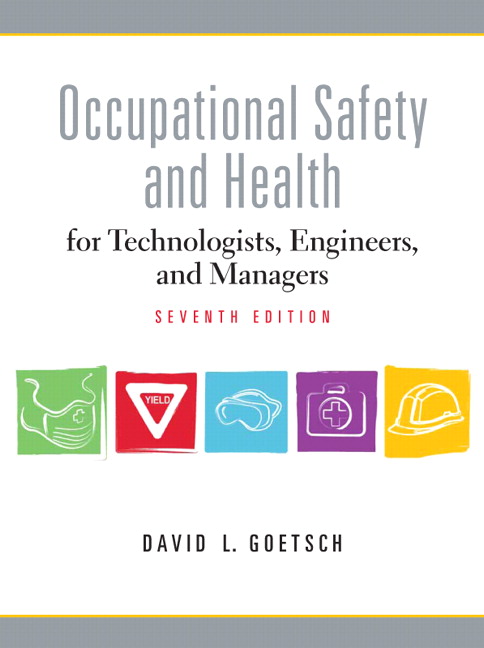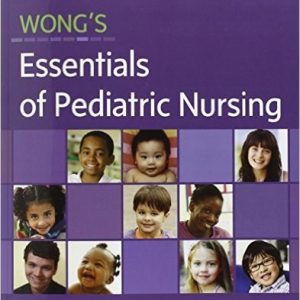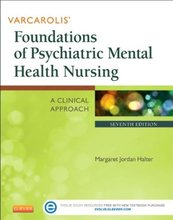This is completed downloadable of Test Bank for Occupational Safety and Health for Technologists, Engineers, and Managers, 7/E 7th Edition David L. Goetsch

Product Details:
- ISBN-10 : 013700916X
- ISBN-13 : 978-0137009169
- Author: David L. Goetsch
Known for its comprehensive coverage, this text covers all aspects of occupational safety and health in today’s global workplace. Appropriate for safety management, engineering and technology programs, the book follows a logical sequence that provides a historical perspective and overview, covers the laws and regulations, discusses the human element, examines hazard assessment, prevention, and control, and covers management of safety and health. This edition features updated OSHA standards and contemporary topics such as safety culture, safety’s role in global competitiveness, workplace violence, natural disasters and terrorism. Some new features include: All OSHA standards, as well as those of other regulatory agencies, were updated Chapter 4: Added a new section on the “;Emerging Role of S
Table of Content:
PART 1 HISTORICAL PERSPECTIVE AND OVERVIEW
1(86)
Safety and Health Movement, Then and Now
3(15)
Developments before the Industrial Revolution
3(1)
Milestones in the Safety Movement
4(2)
Tragedies That Have Changed the Safety Movement
6(3)
Role of Organized Labor
9(1)
Role of Specific Health Problems
9(2)
Development of Accident Prevention Programs
11(1)
Development of Safety Organizations
12(2)
Safety and Health Movement Today
14(1)
Integrated Approach to Safety and Health
14(1)
New Materials, New Processes, and New Problems
15(1)
Rapid Growth in the Profession
15(3)
Accidents and Their Effects
18(14)
Costs of Accidents
19(1)
Accidental Deaths in the United States
19(1)
Accidents versus Other Causes of Death
20(1)
Work Accident Costs and Rates
21(1)
Time Lost Because of Work Injuries
21(1)
Deaths in Work Accidents
22(1)
Work Injuries by Type of Accident
22(1)
Death Rates by Industry
22(1)
Parts of the Body Injured on the Job
23(1)
Chemical Burn Injuries
24(1)
Heat Burn Injuries
24(1)
Repetitive Strain/Soft-Tissue Injuries
25(1)
Estimating the Cost of Accidents
26(3)
Global Impact of Accidents and Injuries
29(3)
Theories of Accident Causation
32(19)
Domino Theory of Accident Causation
32(2)
Human Factors Theory of Accident Causation
34(2)
Accident/Incident Theory of Accident Causation
36(2)
Epidemiological Theory of Accident Causation
38(2)
Systems Theory of Accident Causation
40(2)
Combination Theory of Accident Causation
42(2)
Behavioral Theory of Accident Causation
44(1)
Drugs and Accident Causation
45(1)
Depression and Accident Causation
45(2)
Management Failures and Accident Causation
47(1)
Obesity and Accident Causation
48(3)
Roles and Professional Certifications for Safety and Health Professionals
51(26)
Modern Safety and Health Teams
51(1)
Safety and Health Manager
52(8)
Engineers and Safety
60(5)
Industrial Hygienist
65(1)
Health Physicist
65(1)
Occupational Physician
66(1)
Occupational Health Nurse
67(1)
Risk Manager
68(1)
Certification of Safety and Health Professionals
69(4)
Emerging Role of Safety Professionals
73(4)
Safety, Health, and Competition in the Global Marketplace
77(10)
Competitiveness Defined
77(2)
Productivity and Competitiveness
79(2)
Quality and Competitiveness
81(1)
How Safety and Health Can Improve Competitiveness
81(6)
PART 2 LAWS AND REGULATIONS
87(112)
The OSH Act, Standards, and Liability
89(48)
Rationale for the OSH Act
89(1)
OSHA’s Mission and Purpose
90(1)
OSH Act Coverage
90(1)
OSHA Standards
91(5)
OSHA’s Record Keeping and Reporting
96(6)
Keeping Employees Informed
102(1)
Workplace Inspections and Enforcement
102(1)
OSHA’s Enhanced Enforcement Policy
103(1)
Citations and Penalties
104(2)
Appeals Process
106(1)
State-Level OSHA Programs
107(1)
Services Available from OSHA
107(4)
Employer Rights and Responsibilities
111(1)
Employee Rights and Responsibilities
112(1)
Keeping Up-to-Date on OSHA
113(1)
Problems with OSHA
113(1)
Other Agencies and Organizations
114(5)
OSHA’s General Industry Standards
119(7)
OSHA’s Maritime Standards
126(1)
OSHA’s Construction Standards
127(1)
Standards and Codes
128(2)
Laws and Liability
130(7)
Workers’ Compensation
137(28)
Overview of Workers’ Compensation
137(3)
Historical Perspective
140(1)
Workers’ Compensation Legislation
141(1)
Modern Workers’ Compensation
142(2)
Workers’ Compensation Insurance
144(1)
Resolution of Workers’ Compensation Disputes
145(1)
Injuries and Workers’ Compensation
146(1)
Disabilities and Workers’ Compensation
147(4)
Monetary Benefits of Workers’ Compensation
151(2)
Medical Treatment and Rehabilitation
153(1)
Medical Management of Workplace Injuries
153(1)
Administration and Case Management
154(1)
Cost Allocation
155(1)
Problems with Workers’ Compensation
156(1)
Spotting Workers’ Compensation Fraud and Abuse
156(1)
Future of Workers’ Compensation
157(2)
Cost-Reduction Strategies
159(6)
Accident Investigation and Reporting
165(16)
Types of Accident Investigations
165(1)
When to Investigate
166(1)
What to Investigate
166(2)
Who Should Investigate
168(1)
Conducting the Investigation
169(2)
Interviewing Witnesses
171(2)
Reporting Accidents
173(4)
Ten Accident Investigation Mistakes to Avoid
177(4)
Product Safety and Liability
181(18)
Product Liability and the Law
181(5)
Developing a Product Safety Program
186(1)
Evaluating the Product Safety Program
187(1)
Role of the Safety and Health Professional
188(1)
Quality Management and Product Safety
189(1)
Product Safety Program Record Keeping
190(1)
User Feedback Collection and Analysis
191(1)
Product Literature and Safety
192(1)
Product Recalls and Safety Professionals
193(6)
PART 3 THE HUMAN ELEMENT
199(100)
Ergonomic Hazards: Musculoskeletal Disorders (MSDs) and Cumulative Trauma Disorders (CTDs)
201(32)
Ergonomics Defined
201(1)
Human Factors and Ergonomic Hazards
202(1)
Factors Associated with Physical Stress
203(2)
Ergonomics: A Political Football
205(1)
OSHA’s Voluntary Ergonomics Guidelines
206(2)
Worksite Analysis Program for Ergonomics
208(5)
Hazard Prevention and Control
213(1)
Medical Management Program
214(3)
Training and Education
217(1)
Common Indicators of Problems
217(1)
Identifying Specific Ergonomic Problems
218(2)
Ergonomic Problem-Solving Strategies
220(5)
Economics of Ergonomics
225(1)
Cumulative Trauma Disorders (CTDs)
226(4)
Participatory Ergonomics
230(3)
Stress and Safety
233(11)
Workplace Stress Defined
233(1)
Sources of Workplace Stress
234(2)
Human Reactions to Workplace Stress
236(1)
Measurement of Workplace Stress
237(1)
Shift Work, Stress, and Safety
237(1)
Improving Safety by Reducing Workplace Stress
238(2)
Stress in Safety Managers
240(1)
Stress and Workers’ Compensation
241(3)
Safety and Health Training
244(32)
Rationale for Safety and Health Training
244(4)
Education and Training Requirements
248(3)
Safety and Health Professionals as Trainers
251(2)
Preparing Safety and Health Instruction
253(1)
Presenting Safety and Health Instruction
254(6)
Applying Safety and Health Instruction
260(1)
Evaluating Safety and Health Instruction
260(1)
Training Supervisors
261(2)
Training New and Transferred Employees
263(1)
Job Safety Analysis as a Training Technique
264(2)
Training Opportunities Available
266(2)
Illiteracy and Safety
268(2)
English as a Second Language Training Issues
270(1)
OSHA Standards and Training
271(5)
Violence in the Workplace
276(23)
Occupational Safety and Workplace Violence: The Relationship
276(1)
Workplace Violence: Definitions
277(1)
Workplace Violence: Cases
277(2)
Size of the Problem
279(1)
Legal Considerations
280(2)
Risk-Reduction Strategies
282(2)
Contributing Social and Cultural Factors
284(1)
OSHA’s Voluntary Guidelines
285(7)
Conflict Resolution and Workplace Violence
292(3)
Do’s and Don’ts for Supervisors
295(1)
Emergency Preparedness Plan
296(3)
PART 4 HAZARD ASSESSMENT, PREVENTION, AND CONTROL
299(264)
Mechanical Hazards and Machine Safeguarding
301(21)
Common Mechanical Injuries
301(3)
Safeguarding Defined
304(1)
OSHA’s Requirements for Machine Guarding
305(1)
Risk Assessment in Machine Operation
305(2)
Requirements for All Safeguards
307(1)
Point-of-Operation Guards
307(4)
Point-of-Operation Devices
311(1)
Machine Guarding Self-Assessment
311(1)
Feeding and Ejection Systems
312(1)
Robot Safeguards
313(1)
Control of Hazardous Energy (Lockout/Tagout Systems)
313(5)
General Precautions
318(1)
Basic Program Content
318(1)
Taking Corrective Action
319(3)
Falling, Impact, Acceleration, Lifting, and Vision Hazards
322(34)
Causes of Falls
322(1)
Kinds of Falls
323(1)
Walking and Slipping
324(2)
Slip and Fall Prevention Programs
326(1)
OSHA Fall Protection Standards
327(3)
Ladder Safety
330(2)
What to Do after a Fall
332(1)
Monitor Fall Protection Equipment and Know Why It Fails
333(1)
Impact and Acceleration Hazards
333(9)
Lifting Hazards
342(2)
Standing Hazards
344(2)
Hand Protection
346(3)
Personal Protective Equipment
349(1)
Forklift Safety (Powered Industrial Trucks)
350(6)
Hazards of Temperature Extremes
356(14)
Thermal Comfort
356(1)
Heat Stress and Strain
357(4)
Cold Stress
361(3)
Burns and Their Effects
364(2)
Chemical Burns
366(4)
Pressure Hazards
370(13)
Pressure Hazards Defined
370(1)
Sources of Pressure Hazards
371(1)
Boilers and Pressure Hazards
372(1)
High-Temperature Water Hazards
372(1)
Hazards of Unfired Pressure Vessels
373(1)
Hazards of High-Pressure Systems
373(1)
Cracking Hazards in Pressure Vessels
373(2)
Nondestructive Testing of Pressure Vessels
375(1)
Pressure Dangers to Humans
376(1)
Decompression Procedures
377(1)
Measurement of Pressure Hazards
378(1)
Reduction of Pressure Hazards
378(5)
Electrical Hazards
383(19)
Electrical Hazards Defined
383(3)
Sources of Electrical Hazards
386(3)
Electrical Hazards to Humans
389(1)
Detection of Electrical Hazards
390(1)
Reduction of Electrical Hazards
391(3)
OSHA’s Electrical Standards
394(1)
Electrical Safety Program
395(1)
Electrical Hazards Self-Assessment
395(1)
Prevention of Arc Flash Injuries
396(1)
Training Requirements for Workers
397(5)
Fire Hazards and Life Safety
402(27)
Fire Hazards Defined
403(2)
Sources of Fire Hazards
405(3)
Fire Dangers to Humans
408(1)
Detection of Fire Hazards
409(1)
Reduction of Fire Hazards
410(4)
Development of Fire Safety Standards
414(1)
OSHA Fire Standards
415(1)
Life Safety
415(3)
Flame-Resistant Clothing
418(1)
Fire Safety Programs
419(1)
Explosive Hazards
420(2)
OSHA’s Firefighting Options
422(1)
Self-Assessment in Fire Protection
423(1)
Hot Work Program
423(6)
Industrial Hygiene and Confined Spaces
429(51)
Overview of Industrial Hygiene
429(1)
Industrial Hygiene Standards
430(1)
OSH Act and Industrial Hygiene
431(3)
Hazards in the Workplace
434(2)
Toxic Substances Defined
436(1)
Entry Points for Toxic Agents
436(2)
Effects of Toxic Substances
438(1)
Relationship of Doses and Responses
439(1)
Airborne Contaminants
440(1)
Effects of Airborne Toxics
441(1)
Effects of Carcinogens
442(1)
Asbestos Hazards
443(2)
Indoor Air Quality and “Sick-Building” Syndrome
445(2)
Toxic Mold and Indoor Air Quality
447(1)
Threshold Limit Values
448(2)
Hazard Recognition and Evaluation
450(1)
Prevention and Control
451(3)
NIOSH and Industrial Hygiene
454(1)
NIOSH Guidelines for Respirators
455(4)
Standards and Regulations
459(2)
General Safety Precautions
461(2)
Nanoscale Materials and Industrial Hygiene
463(1)
Confined Space Hazards
463(2)
OSHA Confined Space Standard
465(4)
Confined Space Management Policy
469(2)
OSHA Standards for Toxic and Hazardous Materials
471(1)
OSHA’s Hazard Communication Standard
472(8)
Radiation Hazards
480(17)
Ionizing Radiation: Terms and Concepts
480(2)
Exposure of Employees to Radiation
482(1)
Precautions and Personal Monitoring
482(1)
Caution Signs and Labels
483(1)
Evacuation Warning Signal
484(1)
Instructing and Informing Personnel
484(1)
Storage and Disposal of Radioactive Material
484(1)
Notification of Incidents
485(1)
Reports and Records of Overexposure
485(1)
Notice to Employees
486(2)
Nonionizing Radiation
488(2)
Electromagnetic Fields in the Workplace
490(3)
OSHA Standards for Health and Environmental Controls
493(4)
Noise and Vibration Hazards
497(25)
Hearing Loss Prevention Terms
497(2)
Characteristics of Sound
499(1)
Hazard Levels and Risks
500(1)
Standards and Regulations
501(5)
Workers’ Compensation and Noise Hazards
506(1)
Identifying and Assessing Hazardous Noise Conditions
506(2)
Noise Control Strategies
508(4)
Vibration Hazards
512(2)
Other Effects of Noise Hazards
514(1)
Corporate Policy
514(2)
Evaluating Hearing Loss Prevention Programs
516(6)
Computers, Automation, and Robots
522(17)
Impact of Automation on the Workplace
522(1)
VDTs in Offices and Factories
523(2)
Human-Robot Interaction
525(1)
Safety and Health Problems Associated with Robots
526(2)
Safety and Health in Office Automation
528(1)
Industrial Medicine and Robots
529(2)
Technological Alienation in the Automated Workplace
531(1)
Minimizing the Problems of Automation
532(1)
Challenge for the Future
533(6)
Bloodborne Pathogens and Bacterial Hazards in the Workplace
539(24)
Facts about AIDS
539(1)
Symptoms of AIDS
540(1)
AIDS in the Workplace
541(2)
Legal Concerns
543(3)
AIDS Education
546(1)
Counseling Infected Employees
547(1)
Easing Employees’ Fears about AIDS
548(1)
Protecting Employees from AIDS
548(2)
Hepatitis B Virus (HBV) and Hepatitis C Virus (HCV) in the Workplace
550(3)
OSHA’s Standard on Occupational Exposure to Bloodborne Pathogens
553(4)
Preventing and Responding to Needlestick Injuries
557(1)
Methicillin-Resistant Staphylococcus Aureus (MRSA) in the Workplace
557(6)
PART 5 MANAGEMENT OF SAFETY AND HEALTH
563(144)
Preparing for Emergencies and Terrorism
565(28)
Rationale for Emergency Preparation
565(1)
Emergency Planning and Community Right-to-Know Act
566(1)
Organization and Coordination
567(1)
OSHA Standards
568(1)
First Aid in Emergencies
569(3)
How to Plan for Emergencies
572(2)
Planning for Workers with Disabilities
574(4)
Evacuation Planning
578(1)
Customizing Plans to Meet Local Needs
579(1)
Emergency Response
580(1)
Computers and Emergency Response
581(1)
Dealing with the Psychological Trauma of Emergencies
582(1)
Recovering from Disasters
583(2)
Terrorism in the Workplace
585(3)
Resuming Business after a Disaster
588(5)
Ethics and Safety
593(13)
An Ethical Dilemma
593(1)
Ethics Defined
594(2)
Ethical Behavior in Organizations
596(1)
Safety and Health Professionals’ Role in Ethics
596(2)
Company’s Role in Ethics
598(2)
Handling of Ethical Dilemmas
600(1)
Questions to Ask When Making Decisions
601(1)
Ethics and Whistle-Blowing
601(5)
Hazard Analysis/Prevention and Safety Management
606(23)
Overview of Hazard Analysis
606(1)
Preliminary Hazard Analysis
607(2)
Detailed Hazard Analysis
609(7)
Hazard Prevention and Deterrence
616(2)
OSHA Process Safety Standard
618(2)
Risk Assessment
620(2)
Safety Management Concerns
622(2)
Best Practices in Safety Management
624(2)
Occupational Health and Safety Management Systems
626(3)
Promoting Safety
629(19)
Company Safety Policy
629(1)
Safety Rules and Regulations
630(1)
Employee Participation in Promoting Safety
631(1)
Safety Training
631(1)
Suggestion Programs
632(1)
Visual Awareness
633(1)
Safety Committees
634(2)
Personal Commitment to Workplace Safety
636(1)
Employee-Management Participation
636(1)
Incentives
637(2)
Competition
639(1)
Company-Sponsored Wellness Programs
639(1)
Teamwork Approach to Promoting Safety
640(3)
Persuasion as a Promotional Tool
643(1)
Promoting Off-the-Job Safety
644(4)
Environmental Safety and ISO 14000 (Environmental Management)
648(33)
Safety, Health, and the Environment
648(1)
Legislation and Regulation
649(2)
Types of Environments
651(1)
Role of Safety and Health Professionals
652(1)
Hazards of the Environment
653(4)
Hazardous Waste Reduction
657(4)
Environmental Management System (EMS)
661(4)
International Organization for Standardization (ISO)
665(1)
ISO 14000
666(1)
ISO 14000 Series of Standards
666(2)
ISO 14001 Standard
668(8)
ISO 14000 Success Story
676(5)
TSM: Total Safety Management in a Quality Management Setting
681(13)
What Is QM?
681(1)
How Does QM Relate to Safety?
682(2)
Safety Management in a QM Setting
684(1)
What Is TSM?
684(1)
Translating TSM into Action
685(1)
Fundamental Elements of TSM
686(4)
Rationale for TSM
690(1)
Implementing TSM: The Model
691(3)
Establishing a Safety-First Corporate Culture
694(13)
Safety-First Corporate Culture Defined
694(1)
Importance of Having a Safety-First Corporate Culture
695(1)
Globalization of Competition and Safety
696(1)
How Corporate Cultures Are Created
697(1)
What a Safety-First Corporate Culture Looks Like
698(1)
Ten Steps for Establishing a Safety-First Corporate Culture
698(9)
Glossary
707(17)
Index
724
People Also Search:
occupational safety and health for technologists engineers and managers
occupational safety and health for technologists engineers and managers test bank download pdf
occupational safety and health for technologists engineers and managers download scribd





